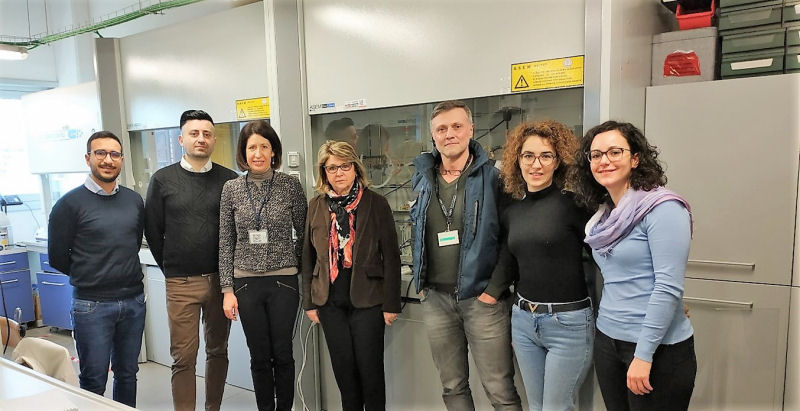 Biomass exploitation The catalytic conversion of renewable resources into chemical intermediates and biofuels represents a sustainable and environmental friendly solution to their increasing demand. This strategy allows the security of supply and economical advantage, in particular when cheap or, indeed, waste or residue raw materials, having a negative value, are employed as starting materials. This last aspect is very important because the employment of waste renewables for chemical transformations does not compete with food and feed production in the well-known “food vs. fuel (or chemicals) conflict”. We have deeply investigated the catalytic conversion of sugars and lignocellulosic biomass (herbaceous crops, waste biomass such as tobacco chops, lemon peels, corn stover, paper mill sludge, etc.) to give furaldehyde, 5-hydroxymethylfuraldehyde (HMF) and levulinic acid. Then we have studied the upgrading of these already valuable chemical intermediates in other compounds of surplus-value such as gamma-valerolactone (GVL), 2-methyl-tetrahydrofuran (MeTHF) and 2-butanol (2-BuOH). MeTHF and GVL are versatile solvents, excellent replacements for tetrahydrofuran and additives for the preparation of alternative fuel transportation mixtures approved by DOE. 2-butanol is mainly used for the synthesis of methylethylketone, but now it has found other applications as solvent and fuel additive due to its high-octane number. Sustainable approaches, such as the use of water medium and heterogeneous catalysts, were adopted. The complete exploitation of lignocellulosic biomass involved the contemporary exploitation of lignin fraction to give polymers, antioxidants, aromatic compounds, activated carbon and composites. Innovative cascade processes based on the synergistic combination of chemical and biological catalysis were studied and optimized. Enzymatic hydrolysis was implemented to produce xylose and glucose from lignocellulosic biomasses and sugars-rich hydrolysates were used as fermentation media to produce new generation bio-oil, namely the “single-cell oil”, through oleaginous yeasts such as Lipomyces starkeyi and Cutaneotrichosporon oleaginosus. Microbial oil was used as a sustainable alternative to vegetable and edible oils to produce biodiesel.
Biomass exploitation The catalytic conversion of renewable resources into chemical intermediates and biofuels represents a sustainable and environmental friendly solution to their increasing demand. This strategy allows the security of supply and economical advantage, in particular when cheap or, indeed, waste or residue raw materials, having a negative value, are employed as starting materials. This last aspect is very important because the employment of waste renewables for chemical transformations does not compete with food and feed production in the well-known “food vs. fuel (or chemicals) conflict”. We have deeply investigated the catalytic conversion of sugars and lignocellulosic biomass (herbaceous crops, waste biomass such as tobacco chops, lemon peels, corn stover, paper mill sludge, etc.) to give furaldehyde, 5-hydroxymethylfuraldehyde (HMF) and levulinic acid. Then we have studied the upgrading of these already valuable chemical intermediates in other compounds of surplus-value such as gamma-valerolactone (GVL), 2-methyl-tetrahydrofuran (MeTHF) and 2-butanol (2-BuOH). MeTHF and GVL are versatile solvents, excellent replacements for tetrahydrofuran and additives for the preparation of alternative fuel transportation mixtures approved by DOE. 2-butanol is mainly used for the synthesis of methylethylketone, but now it has found other applications as solvent and fuel additive due to its high-octane number. Sustainable approaches, such as the use of water medium and heterogeneous catalysts, were adopted. The complete exploitation of lignocellulosic biomass involved the contemporary exploitation of lignin fraction to give polymers, antioxidants, aromatic compounds, activated carbon and composites. Innovative cascade processes based on the synergistic combination of chemical and biological catalysis were studied and optimized. Enzymatic hydrolysis was implemented to produce xylose and glucose from lignocellulosic biomasses and sugars-rich hydrolysates were used as fermentation media to produce new generation bio-oil, namely the “single-cell oil”, through oleaginous yeasts such as Lipomyces starkeyi and Cutaneotrichosporon oleaginosus. Microbial oil was used as a sustainable alternative to vegetable and edible oils to produce biodiesel.
Catalysis and biocatalysis for Sustainability Innovative sustainable catalytic and biocatalytic processes have been studied and optimized. In this respect nontoxic, cheap and/or renewable reagents were adopted, water was preferred as reaction medium and heterogeneous cheap catalysts were selected. Simple and “one-pot” reaction strategies were preferred. The recyclability of the heterogeneous catalysts and the absence of leaching were verified.
Nanomaterials and their applications Microwave (MW)-assisted synthesis allows to attain greener processes characterized by shorter reaction times, reduced energy consumption and better yields. Different single-mode and multi-mode MW-reactors are disposable, also for reactions carried out under inert atmosphere and high pressure.
MW-assisted chemistry Novel synthetic approaches for the preparation of nanocatalysts and nanostructured materials have been deeply studied. Solvothermal and MW-assisted nanocatalysts syntheses (mainly based on Pd, Ru, Pt, Cu, Rh) have been carried out, working in the presence of cheap solvents, and preferring one-pot approaches. Recently novel magnetic nanocatalysts have been synthesized and fully characterized. All these nanocatalysts have been applied in reactions of industrial interest, such as hydrogenations, selective oxidations, C-C couplings, condensations.
Home Page
GREENCAT
Green Catalysis beyond Petroleum Age
● ● ●
Department of Chemistry and Industrial Chemistry
Via Giuseppe Moruzzi, 13
56124 - Pisa, Italy
RASPOLLI RESEARCH GROUP
greencat.dcci.unipi.it
● ● ●
Powered by
WMkk-Dcci-Unipi
Privacy Policy






